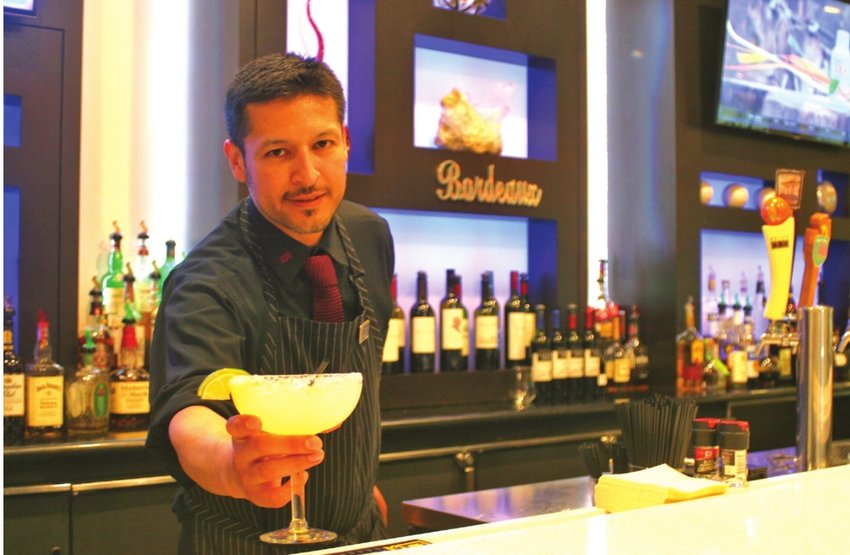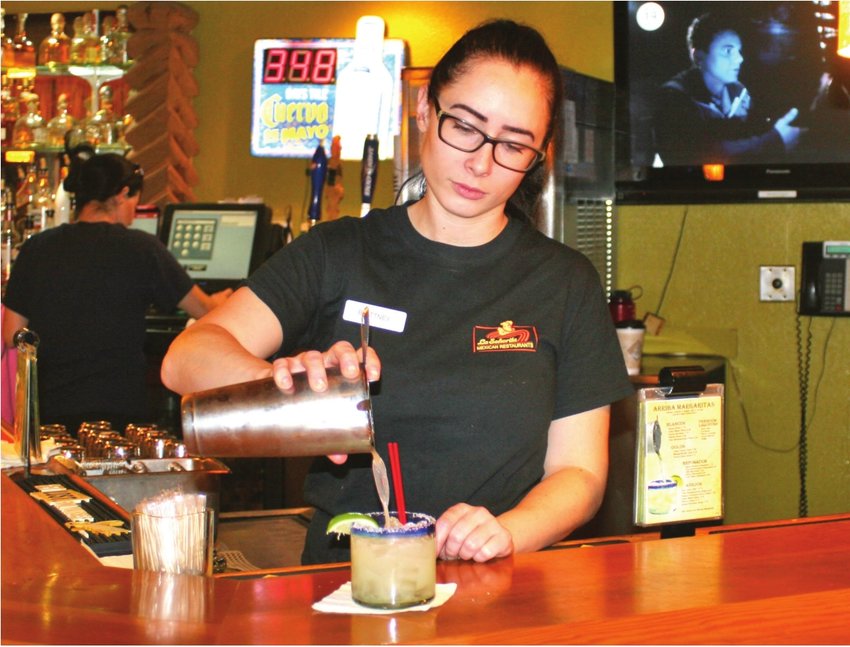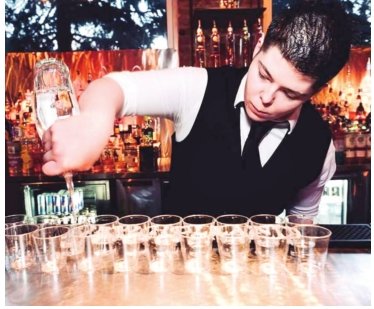
There are so many unanswered questions about the margarita.
Is the margarita the vulgar, sticky, frog-hued head crusher of spring break infamy, or the latest artisanal trend in cocktail artistry? Is it a drink fit for parrotheads or poets? Is it a George Clooney, silver fox, sort of libation or a red rocking, Sammy Hagar-style pounder?
Was the margarita born when sacred nectar first ran down a dusty Mexican mountainside from the spiky agave plant, or when a New York bartender found a new way to slake the thirst of parched Wall Street stockbrokers?
Whether you got out of school just last week or it’s been 50 years since you’ve seen a multiple-choice exam, you already know the answer: all of the above.
Hide the blender
For some straight talk about the ultimate drink of summer, I went to a bartender named — of course — Joe.
Taking advantage of a mid-afternoon lull last Thursday, Joe Gamez was folding napkins at high-end restaurant Bordeaux in Lansing’s Crowne Plaza hotel on the west side.
 Gamez has quenched the thirst of many white-collar stiffs, fresh from seminars at the hotel, and many more who drop in from nearby insurance giant Auto-Owners, ready to cool down and numb up.
Gamez has quenched the thirst of many white-collar stiffs, fresh from seminars at the hotel, and many more who drop in from nearby insurance giant Auto-Owners, ready to cool down and numb up.
“This time of year, we get people in here who want to feel the summertime, and that’s the cocktail they go for,” he said.
Joe knows a lot of stories, but just as I settled in for a long talk, he clammed up and got ethical on me.
Gamez is heading the Bordeaux crew in Friday’s first-ever Margarita Fest, sponsored by City Pulse and the Lansing Entertainment and Public Facilities Authority, when 13 local establishments will offer the best margaritas, and he has a few tricks up his sleeve he won’t divulge.
He let me sample an amazing substance he formulated out of … and that he plans to … but alas, I’m sworn to secrecy.
“We’re in this to win it,” Gamez said. “By the way, what are you hearing from the other places?” Nice try, Joe.
All 13 entrants in the contest will have to use the same Cuervo Silver tequila, so other factors will have to make the difference.
Fortunately, there are endless ways to change up the basic formula of tequila, salt, orange liqueur and lime juice.
Gamez and his rivals from other competing establishments plan to ring some tasty variations on the simple syrups, rim coatings and sour mix, for starters. And there’s this other … damn, I wish I hadn’t promised Joe I’d keep his secrets. Suffice it to say the man is an artist.
There is one thing Joe doesn’t mind people knowing about. Don’t expect him to fix you a frozen margarita, the classic margarita’s slushy, slumming, slutty sister.
“I hide the blender,” Gamez said. “I don’t like to use it.”
It comes in vats
The top of the Margarita ziggurat in greater Lansing is East Lansing’s El Azteco, the state’s biggest purveyor of Jose Cuervo tequila. On a busy night, El Az East goes through 50 gallons of margaritas — about 200 pitchers.
The margaritas are held in 15-gallon drums and drawn from a tap.
“It’s a really interesting process where it’s always mixing,” Billy Smalley said. Smalley is assistant general manager, former bar manager and acknowledged tequila poobah at El Azteco East. He also tends bar at Dublin Square.
Somewhere back of house, pumps keep the tequila circulating through holding tanks “so nothing sinks and the density is uniform,” he explained.
Vats of margaritas! Can I see? “I’d love to show you, but I can’t,” he said. “It’s proprietary.”
El Az runs the gamut, from high-end margaritas made from any of 109 varieties of tequila to, yes, the frozen concoctions that help you hang on.
“We just got two more frozen margarita machines and we’re going into six more flavors,” Smalley said.
What can you do? People like what they like. The top seller at El Az is the classic Cuervo margarita, the same recipe the restaurant has used for 40 years. “The proportions are always the same,” Smalley said. “Customers know what they’re going to get. It just works. It’s the perfect proportion of sweet, sour, fruitiness.”
It used to be called the Golden Margarita because it has Cuervo Gold — not the best variety, Smalley admits, but people like the color.
“Golden tequilas are not aged,” he said. “They are normally mixed with caramel coloring or some other additive to give that gold hue.”
That’s a daisy
Before we venture into the scrublands of Mexico and sacrifice too many brain cells to the agave gods, let us take a detour into the history of the margarita.
Several margarita origin stories involve beautiful women of that name. (It makes you wonder what stories you’d hear if the drink were called Lester.)
Film bombshell and pin-up girl Rita Hayworth, whose real name was Margarita Cansino, may have inspired a bartender to mix the first margarita. There’s a similar story about a smitten bartender mixing the first margarita for singer Peggy Lee, whose real name was Norma Egstrom. (But Peggy is a nickname for Margaret.)
According to the most often told tale, Mexican restaurant owner Carlos (Danny) Hererra created it in 1938 for Ziegfeld showgirl Marjorie King, who was allergic to all booze except tequila.
Another story credits Texas socialite Margaret (Margarita) Sames with mixing the first margarita, using Tequila Herradura, Cointreau and fresh lime juice, at a house party one dusty afternoon at her cliffside hacienda in Acapulco in 1948.
According to the Oxford English Dictionary, the name of the drink first appeared in print in 1965, but the drink reportedly appeared in Jose Cuervo ads in the 1940s.
The closest thing we have to a rigorous cocktail historian is David Wondrich, a former English professor and jazz critic with a rectangular, coypu-like patch of facial hair. Since the 1990s, Wondrich has moved to the top of the world’s cocktail experts as a contributing editor of Esquire.
In his award-winning book “Imbibe!” Wondrich bypassed the unverifiable legends and traced the margarita all the way back to an 1866 novel, “Gay Life in New York, or Fast Men and Grass Widows,” by Henry Llewellyn Williams.

In the novel, a man named Charlie complains about his romantic troubles to a friend at a bar and orders a glass of lemonade.
“Nonsense, man,” his friend interjects. ”Wouldn’t you rather have a concentrated zephyr, in a daisy, or an iced dew drop?” The concentrated zephyr and the iced dew drop are lost to history, but the “daisy” stuck around to enjoy two distinct lives. Wondrich traced the next mention of the daisy to the 1870s, when former Hoffman House bartender Fred Eberlin ran a bar on New Street, around the corner from the New York Stock Exchange.
On July 7, 1873, a man named Billy Taylor asked Frank, the bartender, for “something new.” Frank recalled the day 24 years later for a story in the New York Press — with “unusually precise” memory, Wondrich admits.
Taylor took a sip and said, “By George, that’s a daisy!” But what was in it? Eberlin’s precise memory faltered at that point.
He claimed to put “a bit of Frank” in the drink, which didn’t help people trying to replicate it.
In 1883, a bartender at Eberlin’s told a reporter from The New York Journal that a drink called the “whiskey daisy,” something like a whiskey sour, had become popular there in recent years.
The first Whiskey Daisy recipe was published in the 1876 second edition of Jerry Thomas’ Bar- Tenders Guide. It was whiskey and lemon juice, sweetened with orange cordial.
Wondrich recounts that in the 1890s, the Daisy evolved into a “dude’s drink, empinkened with first raspberry syrup and then grenadine — the new, wonder sweetener of the age — and decanted into some sort of recherché, ice-filled goblet … and tricked out with fruit.”
Take another sip — we are about to get to the point of all this. While Prohibition was going on in the United States, a new cocktail was introduced at a gambling and golf resort at Agua Caliente, near Tijuana.
The ingredients were tequila, lime juice, grenadine, a little crème de cassis, ice and soda.
The drink was called a Sunrise Tequila on the bar list, but it reminded Americans visiting the resort of the drink Eberlin made famous back in New York, so they called it a tequila daisy.
In 1936, according to Wondrich, a tequila daisy appeared on the menu at a bar in Syracuse, New York — tequila, orange liqueur, lime juice (more common in Mexico than lemon juice). People started ordering them by the Spanish word for “daisy” — margarita.
From then on, the name “margarita” began to stick to the rim of public consciousness (or unconsciousness). By 1945, the first importer of Jose Cuervo in the United States was using the tagline “Margarita: It’s more than a girls’ name,” according to “The Complete Book of Spirits,” by Anthony Dias Blue.

Big business
There are plenty of exotic tequila legends you can read on the back of restaurant menus, most of them involving volcanos and capricious deities. The generic version popped up in a May 2018 “Far and Away” story in National Geographic and The Wall Street Journal.
One fateful day, lighting struck a volcanic mountainside near Tequila, Mexico, tearing open a spiky blue agave plant to its “maguey,” or heart. The Nahua tribe tasted the intoxicating, sweet juice that ran from the wound and the rest is history.
Around 1800, King Carlos IV of Spain licensed the Cuervo family to distill tequila after a period of prohibition under his predecessor, Carlos III. Now tequila is a regional beverage, like Champagne or Bourdeau, made only from the blue agave plant that grows in the Tequila region and the central western Mexican state of Jalisco.
Tequila has had its ups and downs, but it’s come a long way since it was the binge drink of choice for American college students on spring break, trying, usually in vain, to catch some of the magic of the infamous 1972 Rolling Stones “Tequila Sunrise” tour.
Now you can get a $4,000 Jose Cuervo Rolling Stones anniversary edition bottle (in a guitar case) that, appropriately, is “extra añejo,” or aged more than most, complete with a gilt-edged tongue logo.
Artisanal tequilas are produced from a particular agave field with its own terroir, like wine. Bottles are made of crystal or studded with gold and the tequila can sell in the four or even five figures.
“A lot of people get the bad reputation with tequila from their college days — El Toro, the cheapest bottom barrel you can drink,” El Azteco's Smalley said. “Those are always mixtos or oro, not 100 percent agave, and there’s caramel coloring or some other additive, and that’s the big hangover factor. Most tequila is gluten free, very clean.”
Smalley took me on a tour of the three main varieties of tequila: blanco (not aged), reposado, or “rested” (aged a few months) and añejo (aged several months or a few years).
The flavors ranged from the clean, crisp, fruity and floral blanco to the roasted, almond-y reposado to the oaky, cognac-like mellowness of añejo.
Just for fun, Smalley matched a few of the tequilas lining the rooftop bar with their celebrity familiars.
“Casa Nobel — that’s Carlos Santana’s tequila,” he said. “Cabo Wabo is Sammy Hagar’s. Our 901 blanco is Justin Timberlake’s tequila. And recently Casamigos, George Clooney’s tequila, sold for about a billion dollars.”
For centuries, tequila has been Mexico’s signature export, and now it’s bigger business than ever. In June 2017, as Smalley noted, British conglomerate Diageo paid $1 billion for Casamigos, the tequila company co-founded by Clooney and Rande Gerber, husband of supermodel Cindy Crawford. In an even bigger transaction in January 2018, Bacardi bought tequila manufacturer Patrón for an estimated $5 billion.
Custom made
Across town from El Azteco, Brittney Davis of La Senorita was hustling to keep up with a growing lunch crowd last Thursday. But with the margarita contest drawing near, she took a few minutes to tout team La Senorita.
“We have a house-made mix, not premade, with fresh lime juice and our own ingredients, and you can tell when you drink it,” she said.
Three Generaciones is her favorite tequila.
“It’s just really smooth, not much of a bite, you can tell it’s been aged a little bit,” she said. “I like it in a margarita, though. I don’t drink tequila straight.”
And that’s why we have margaritas. Davis whips up a fine arriba, the restaurant’s signature margarita, but custom margaritas are a big thing at La Senorita, too.
Customers can order margaritas made with blancos, golds, reposados or añejos, with five choices of liqueur: Gran Gala, Cointreau, Grand Marnier and Patron Citronge (all orange liquers) and PAMA (a pomegranate liqueur). Hornito’s anejo (aged in American oak barrels) and Cabo Wabo are among the most popular tequilas.
I had a few more questions for Davis, but she was already whisking to and fro, bringing food and drinks to the proliferating clientele. Outside, the temperature was pushing 80 degrees, June was around the corner, and people were getting very thirsty.
Participants of margarita fest.
Thirteen bars and restaurants will put their best margarita foot forward at Friday's Margarita Fest. We asked all of them to reveal their recipes. Here's what we learned from the six that responded.

Spiral dance bar
Elizabeth Deatrick, general manager
“I’ve worked for Spiral for 10 years now.
Nine as a bartender and one as the general manager. I love to make cocktails on and off the menu that you won’t find anywhere else. Taking classic and new, and mixing them together for something fun and unique. Our featured margarita will have a blend of classic and tropical with the hopes to mentally send you to an island beach with the sand in your toes, sun on your skin and the wind in your hair.”

American fifth spirits
Rick Wyble, owner
“We’re developing that. I don’t have an answer yet! We’ll have a little bit of spice, a little bit of herb and we’re trying to figure out our juice selection. But, we’re looking forward to being involved. We’re excited it’s happening Lansing and promoting margaritas and cocktails in general.”

Lansing lugnuts
Trey Austin, lead bartender
“I’m gonna have to be secretive at this moment. We just found out the super dynamics of what we’re trying to do. I feel like I need to recreate my initial components, which was gonna be a cherry based margarita. I feel like I need to go a little more intricate, it might stay in that vein, but I might branch out a little bit.”
La Senorita
George Wills, general manager
“For Margarita Fest, our bartenders Brittney Davis, Jessica Taranto, Reyn Semmler, Lynsey Wills and Michelle Meisch have come up with a very refreshing take on the classic margarita. They will be serving a jalapeno-cucumber margarita. This concoction is truly perfect for the hot summer night we’re hoping to enjoy downtown Friday, June 1. Mixing the cucumber with the jalapeno gives a very bold and refreshing flavor to this margarita. It definitely will both soothe and surprise your palate.”

Acapulco
Miguel Pozos Bartender (pictured) “We have two margaritas. One of them is going to be our Skinny Margarita and the oth er one is called the Ultimate Margarita. In the Skinny Margarita we use fresh lime juice, agave syrup, and Cointreau. And in the Ultimate Margarita it’s triple sec, orange curaçao, sweet and sour, and lime juice," said Jorge Vera, manager of Acapulco.
Houlihans
Collin Williams, general manager “We are making the Metal Margarita, a rock ‘n’ roll themed margarita sure to be the star of the show. Houlihans Bartenders Audrey and Jen are excited to pour up their unique concoction sure to rock the crowd!”
Support City Pulse - Donate Today!
Comments
No comments on this item Please log in to comment by clicking here